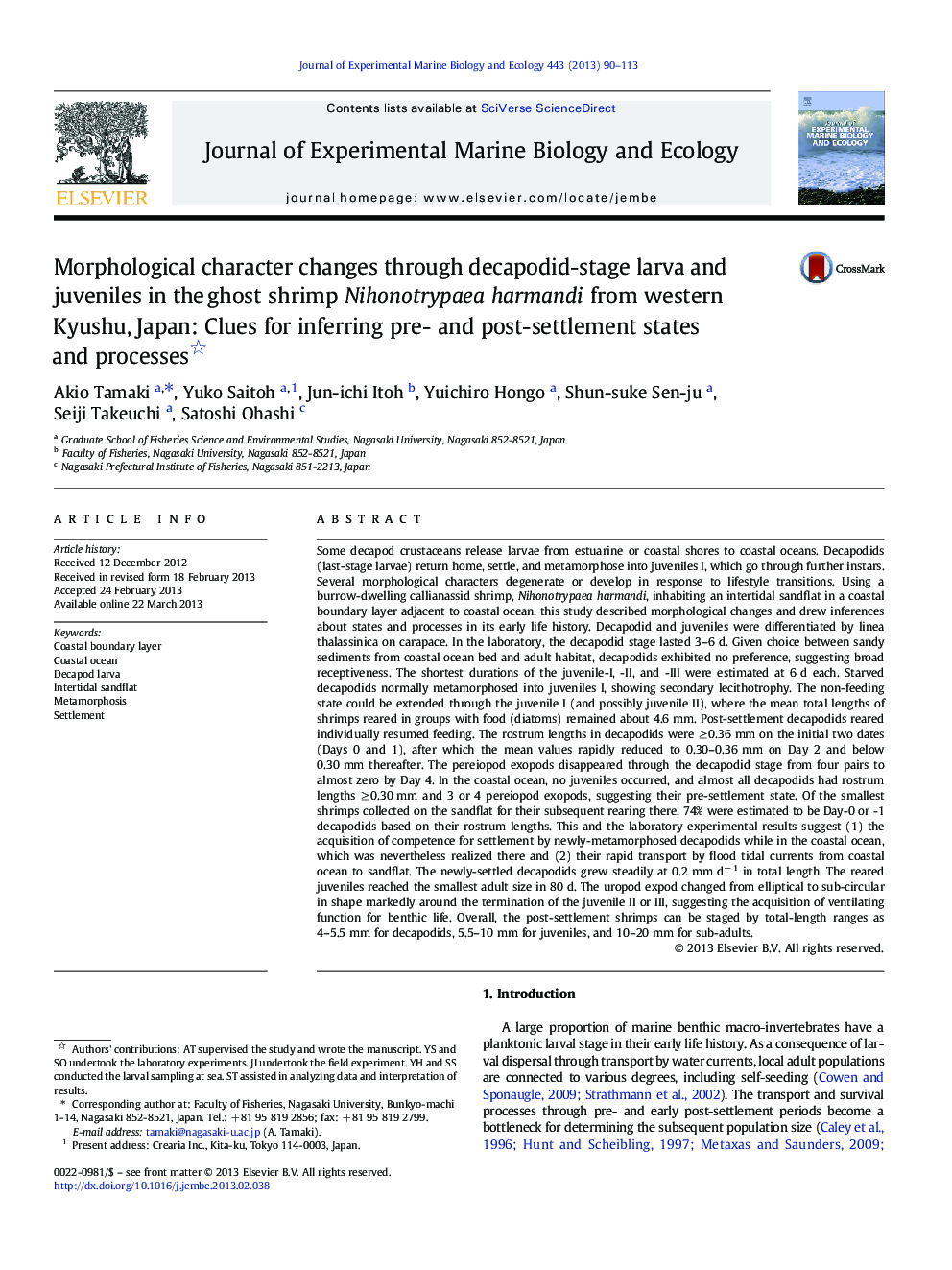| کد مقاله | کد نشریه | سال انتشار | مقاله انگلیسی | نسخه تمام متن |
|---|---|---|---|---|
| 4395777 | 1618432 | 2013 | 24 صفحه PDF | دانلود رایگان |

• Decapodid and juveniles of a callianassid shrimp were reared in laboratory and field.
• Ontogenetic morphological change and growth in decapodid and juveniles were given.
• Feeding mode, substratum selectivity, and duration for decapodid stage were examined
• Two degenerating characters gave clues to infer states in field-collected decapodids.
• One developing character in juveniles was related with burrow-dwelling lifestyle.
Some decapod crustaceans release larvae from estuarine or coastal shores to coastal oceans. Decapodids (last-stage larvae) return home, settle, and metamorphose into juveniles I, which go through further instars. Several morphological characters degenerate or develop in response to lifestyle transitions. Using a burrow-dwelling callianassid shrimp, Nihonotrypaea harmandi, inhabiting an intertidal sandflat in a coastal boundary layer adjacent to coastal ocean, this study described morphological changes and drew inferences about states and processes in its early life history. Decapodid and juveniles were differentiated by linea thalassinica on carapace. In the laboratory, the decapodid stage lasted 3–6 d. Given choice between sandy sediments from coastal ocean bed and adult habitat, decapodids exhibited no preference, suggesting broad receptiveness. The shortest durations of the juvenile-I, -II, and -III were estimated at 6 d each. Starved decapodids normally metamorphosed into juveniles I, showing secondary lecithotrophy. The non-feeding state could be extended through the juvenile I (and possibly juvenile II), where the mean total lengths of shrimps reared in groups with food (diatoms) remained about 4.6 mm. Post-settlement decapodids reared individually resumed feeding. The rostrum lengths in decapodids were ≥ 0.36 mm on the initial two dates (Days 0 and 1), after which the mean values rapidly reduced to 0.30–0.36 mm on Day 2 and below 0.30 mm thereafter. The pereiopod exopods disappeared through the decapodid stage from four pairs to almost zero by Day 4. In the coastal ocean, no juveniles occurred, and almost all decapodids had rostrum lengths ≥ 0.30 mm and 3 or 4 pereiopod exopods, suggesting their pre-settlement state. Of the smallest shrimps collected on the sandflat for their subsequent rearing there, 74% were estimated to be Day-0 or -1 decapodids based on their rostrum lengths. This and the laboratory experimental results suggest (1) the acquisition of competence for settlement by newly-metamorphosed decapodids while in the coastal ocean, which was nevertheless realized there and (2) their rapid transport by flood tidal currents from coastal ocean to sandflat. The newly-settled decapodids grew steadily at 0.2 mm d− 1 in total length. The reared juveniles reached the smallest adult size in 80 d. The uropod expod changed from elliptical to sub-circular in shape markedly around the termination of the juvenile II or III, suggesting the acquisition of ventilating function for benthic life. Overall, the post-settlement shrimps can be staged by total-length ranges as 4–5.5 mm for decapodids, 5.5–10 mm for juveniles, and 10–20 mm for sub-adults.
Journal: Journal of Experimental Marine Biology and Ecology - Volume 443, May 2013, Pages 90–113